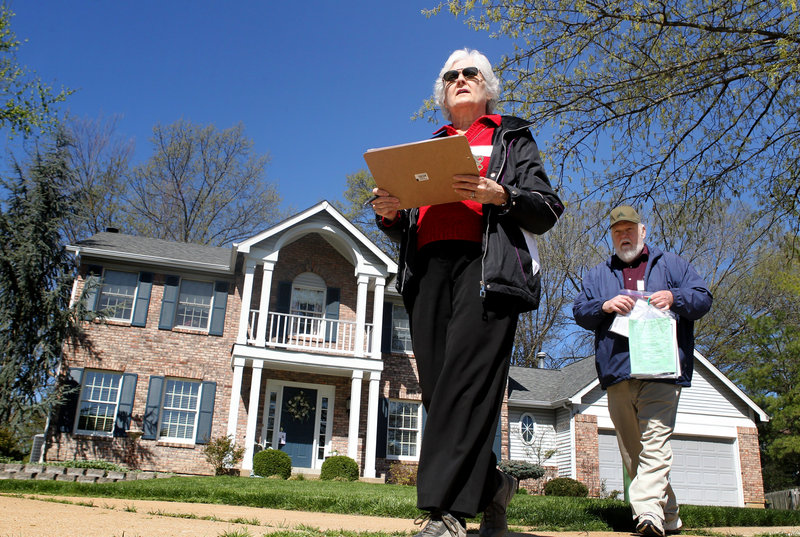SHREWSBURY, Mo. – On a rainy Saturday in March, about 125 Catholics packed the Fleur de Lis Room in the basement of the St. Louis Archdiocese headquarters here. Most of those in the room were older. Most were lay people. Many were representing their parishes.
The St. Louis Post-Dispatch reported that they gathered here to learn how to spread the faith, a concept that is both fundamental to Christianity and nearly foreign to modern Roman Catholics.
For the first hour of the conference, Kenneth Livengood, a parishioner at Holy Trinity Parish in St. Ann, detailed one way – door-to-door evangelization, a missionary strategy more familiar to Mormons or Jehovah’s Witnesses.
“We’ve been tricked into thinking faith is a private matter,” Livengood told the audience. “That’s a lie. Faith is meant to be public, and there are many ways to share it.”
He taught them how to form a door-to-door ministry, explained how to divide a boundary map of their parish to more easily evangelize in geographical sections, suggested useful handouts to carry, gave safety tips, and showed videos that detailed the best way to respond to various reactions from those on the other side of the door.
“Divide up into teams of two,” Livengood said. “One of you can do the talking and the other should be a silent prayer warrior. At the next house, flip your roles.”
Evangelization is central to the Christian mission, but for the average adherent the physical act of approaching a neighbor, work colleague or family member can be daunting.
An Archdiocese of St. Louis pamphlet called “Witnessing Christ Door-to-Door” handed out at the conference offered a list of suggestions “since this may be a novel, perhaps, intimidating path.”
The suggestions include:
• “Ask each person you meet if they are in need of prayer.”
• “Early Saturday mornings may not make for the most receptive ears.”
• “Trying to provide too many facts about the Church may cause misunderstandings.”
• “Doing a little role-playing before going out for visits may be helpful.”
• “Sometimes a person answering the door thinks getting back to regular Mass attendance would make their grandmothers very happy, which might present a welcoming start for conversation.”
Going door to door “is not really a Catholic practice that we’ve done often in the past,” said the Rev. Stephen Bevans, professor of mission and culture at Catholic Theological Union in Chicago.
In the final scene of the Gospel of Matthew, the resurrected Christ appears to his disciples on a mountain in Galilee. He tells them – in what has come to be called the “Great Commission” – to make new disciples by “teaching them to observe all that I have commanded you.”
It is this instruction that propels evangelicals to make converts by spreading the Gospel.
The term “gospel” comes from “euaggelion,” the Greek word for “good announcement,” and refers to the style of writing – a proclamation of “good news.”
Catholics are no less engaged by the Great Commission, but over the last century, the church and its reliance on evangelizing through the example of its social justice mission (feeding the poor, building hospitals) has relieved those in the pews from having to knock on a neighbor’s door.
In the late 1980s, Bevans said, Pope John Paul II began referring to “the new evangelization” as a strategy of bringing lapsed Catholics in Europe back into the church.
In his book “Crossing the Threshold of Hope,” the pope wrote that evangelization “has never been absent” in the church. He quoted the apostle Paul from the book of 1 Corinthians: “Woe to me if I do not preach the Gospel!”
John Paul was also concerned about stolen sheep. In a reference to the Pentecostal movement that has challenged the Catholic church’s dominance of Latin America, the pope told Latin American bishops in 1992 to “feed the flock entrusted to you and defend it from rapacious wolves.”
Send questions/comments to the editors.



Success. Please wait for the page to reload. If the page does not reload within 5 seconds, please refresh the page.
Enter your email and password to access comments.
Hi, to comment on stories you must . This profile is in addition to your subscription and website login.
Already have a commenting profile? .
Invalid username/password.
Please check your email to confirm and complete your registration.
Only subscribers are eligible to post comments. Please subscribe or login first for digital access. Here’s why.
Use the form below to reset your password. When you've submitted your account email, we will send an email with a reset code.